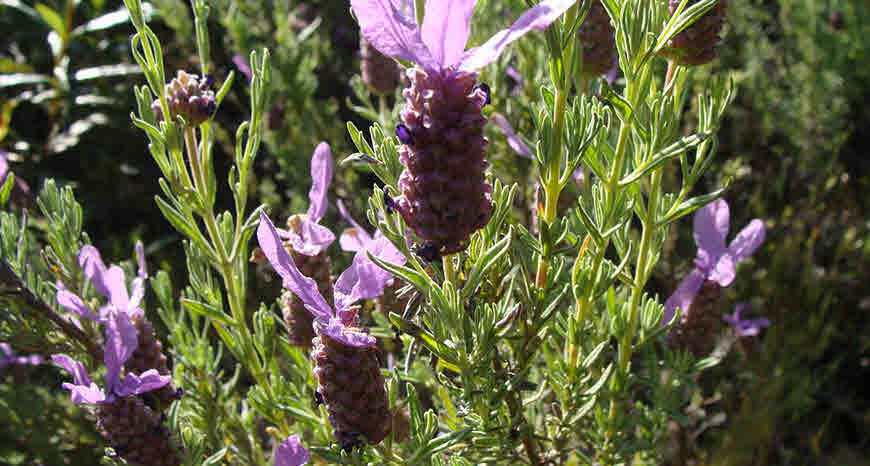Botanical name of Arabian or French lavender is Lavandula stoechas. It is a perennial ornamental, and medicinal plant. French lavender bears beautiful flowers which are bright purplish-pink. The flower blooms from mid-spring to autumn. French lavender is used for a folk medicine in many countries. The extract of flowers has antibacterial, antifungal, and antioxidant properties.

In Unani medicine it is known as Ustukhuddus, and used in the treatment of a variety of diseases. In Unani literature, it is considered antiseptic, deobstruent, demulcent, phlegmagogue, nervine Tonic, antianxiety, and anticonvulsant. It removes black bile from the brain, gives strength, and improves the intellect, and hence called Jaroobe dimagh which literally means broom of brain. It is also used to treat headache, and diseases due to the nervine weakness.
General Information
There are about 32 species of Lavandula which are distributed from the Canary Islands, Madeira, Mediterranean Basin, North Africa, South West Asia, Arabian Peninsula, and India.
Lavandula stoechas is a native of the Mediterranean region. The plant grows to 0.8 m (2ft 7in) by 0.8 m (2ft 7in). Flowers are hermaphrodite having both male, and female organs. They are pollinated by insects. The dried plant, and flowers are used for medicinal purpose. The flowers have camphor like smell.
Scientific Classification
The botanical name of Common lavender is Lavandula stoechas. It belongs to plant family Lamiaceae. Below is given taxonomical classification of the plant.
- Kingdom: Plantae – Plants
- Subkingdom: Tracheobionta – Vascular plants
- Superdivision: Spermatophyta – Seed plants
- Division: Magnoliophyta – Flowering plants
- Class: Magnoliopsida – Dicotyledons
- Subclass: Asteridae
- Order: Lamiales
- Family: Lamiaceae / Labiatae – Mint family
- Genus: Lavandula L. – lavender
- Species: Lavandula stoechas L. – French lavender
Synonyms
Stoechas officinarum
- Part(s) used for medicinal purpose: Leaves, flowers
- Plant type: compact subshrub
- Distribution: Canary Islands, Madeira, Mediterranean Basin, North Africa, South West Asia, Arabian Peninsula, and India
- Habitat: Dry hills, garigue, and open woods on limestone, and granite soils
Vernacular names / Synonyms
- Scientific name: Lavandula stoechas
- Common Name: Spanish Lavender, French Lavender, Arabian Lavender
- English: Common lavender, French lavender
- Unani: Ustukhuddus, Ustikuus
- Hindi: Dharu, Alphagandharu
- Spain: Romero Santo
- Arabic: Anisul arwah, Mumsikul arwah
Few Unani Formulations
- Majoon-e-najah
- Itrifal Ustukhuddus
Constituents of Lavandula stoechas
Lavandula stoechas contains organic, inorganic substances, and essential oil (0.77-1.2%). Linalyl acetate (15.26%), linalool (10.68%), 1-8 cineole (10.25%), terpinene (11.2%), and camphor (11.25%) are present in essential oil of the dried flower.
Important Medicinal Properties
- Mus-hil Balghem (Phlegm Purgative)
- Musaffi Dam (Blood purifier)
- Mufatteh (Deobstruent)
- Muqavvi Aasab (Nervine tonic)
- Munzij Balghem (Phlegm concoctive)
- Munzij Sauda (Melancholic concoctive)
- Murr, Talkh, (bitter)
Medicinal Uses of Ustukhuddus / Arabian or French lavender
- It is used in Unani for treating brain disorders.
- It is a brain Tonic, and improves the intelligence.
- It removes confusion of mind.
- It enhance memory.
- It manages depression, and anxiety.
- It strengthens mind, and cures mental fatigue.
- It is used in combination with other herbs for depression, headaches, migraine.
- It is given to cure cough, and chronic catarrh.
- It is effective in sinusitis.
The Dosage of Lavandula stoechas
- The recommended dose is 3-6 grams.
- Contraindications, Interactions, Side-effects, and Warnings Lavandula stoechas
- It should not be taken in excess in pregnancy.
- Lavender oil in large doses is a narcotic poison.
- Frequent intake can cause abdominal pain.
- It interact with diuretic, and blood pressure lowering medicines.
Lavandula Stoechas is not the same as French lavender which is Lavandula Angustifolia
I grow and produce lavandula stoechas essential oil in France, as well as lavandula Angustifolia
they are very different oils
I have a lab analysis of the oil if you are interested
Kindly give me more details in support of your comment.
i will be glad if you can email me with references to the same at javed.yusramaryam@gmail.com
https://pubmed.ncbi.nlm.nih.gov/35007684/
https://www.researchgate.net/publication/349672047_Ustukhuddus_Lavandula_stoechas_L_A_Boon_for_the_Management_of_Neuropsychiatric_Disorders_in_Perspective_of_Unani_Medicine-A_Review
Hi would like to know more